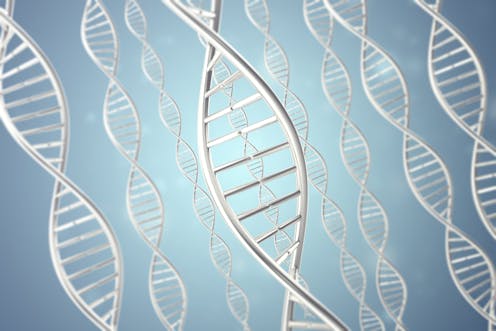Custom-built DNA could be used as a sensor probe
- Written by Konstantinos Vavitsas, CSIRO Future Science Fellow in Synthetic Biology, The University of Queensland

Researchers believe that DNA – the molecule that stores information about life – could one day be used as a type of sensor, to record information based on its surroundings.
Synthetic DNA (not produced in an organism and not containing genetic information of a species) has already been used to store data, as a sort of biological hard drive.
But now, MIT researchers Weixin Tang and David Liu say that their CAMERA system (acronym for CRISPR-mediated analogue multi-event recording apparatus) makes bacteria able to record their surroundings.
Read more: What is CRISPR gene editing, and how does it work?
The microbes are able to sense and note in their DNA the presence or absence of sunlight, antibiotics, or nutrients in their vicinity.
This system has two variations.
CAMERA 1 records the presence and intensity of an external molecule by changing the ratio of two small circular DNA pieces (called plasmid) inside the bacteria. This allows you to determine whether, how much and for how long the microbe was sensing the external molecule.
CAMERA 2 is more advanced and records by making a DNA edit (imagine the equivalent of burning a DVD, but on the genome).
Both systems can keep the information records steady for several hours. And as a true recording device, it has a “reset” function that cleans the information and sets the system ready for another recording.
How it works
An audio or video recorder in effect translates information. The composition and complexity of photons and sound waves is transformed in a way possible to store. A reading device then retrieves that information.
The same principles apply to recording in DNA format, and in this case there are two technologies that make this possible.
The first one is CRISPR/Cas9, a gene editing tool. CRISPR can target DNA sequences very precisely. In CAMERA 1, CRISPR works by breaking down one of these two circular DNA pieces, changing their ratio.
CAMERA 2 uses CRISPR to make small changes to the original DNA sequence. When the molecule of interest is in the environment, it causes the cells to produce CRISPR in a controlled manner. In that way, the result is precise and tied closely to the external cue.
The second technology is DNA sequencing, and in particular next generation sequencing. The information recorded needs to be retrieved and analysed.
That may sound straightforward, but keep in mind that we need to detect a few changes in a one or two letters out of the few million letters that make the bacterial genome.
Next generation sequencing allows reading DNA in very high speed and very high accuracy. More importantly, it makes the cost of reading DNA drop, making routine sequencing applications financially viable.
What can we use it for?
There are advantages of such a system compared to current sensors.
The applications on basic research are obvious. A recording device can store information about the history of a cell and tell us, for example, when a pathogen starts producing a toxin, or when the nutrients run low in a cell.
In order to answer such questions currently, we need to use either reporter genes, that require constant monitoring, or expensive and invasive metabolomics techniques.
The biggest application potential lies in micro-sensors. Specialised cells could monitor the concentrations of a varying of compounds.
The advantage to current chemical/electrical sensors is that biological systems are more versatile in monitoring and reacting to many compounds with high accuracy. As only a few molecules are needed for a successful recorder, bio-sensors can be smaller in size and record multiple signals at the same time.
The next breakthrough
In my opinion, a true breakthrough in the technology would be the development of a cell-free DNA recorder.
Recording in cells limits the recording environments to these that the cell can grow. A cell-free system, containing only the sensing molecules and the DNA-recording apparatus would have a number of advantages.
Read more: Storing data in DNA brings nature into the digital universe
The information would be easier to access and assess, as it would not be buried in the genome of the organism. The system would be simpler, thus easier to calibrate and optimise. Moreover there would be a reduced risk for contamination, as it would not contain a living organism and it would rely on fully synthetic DNA.
Synthetic biology is promising to revolutionise biological research and applications. These developments have become possible due to the reduced cost to read and write DNA.
I expect more and more creative uses of this fundamental molecule of life, and exciting applications in our everyday life.
Authors: Konstantinos Vavitsas, CSIRO Future Science Fellow in Synthetic Biology, The University of Queensland
Read more http://theconversation.com/custom-built-dna-could-be-used-as-a-sensor-probe-95226



















